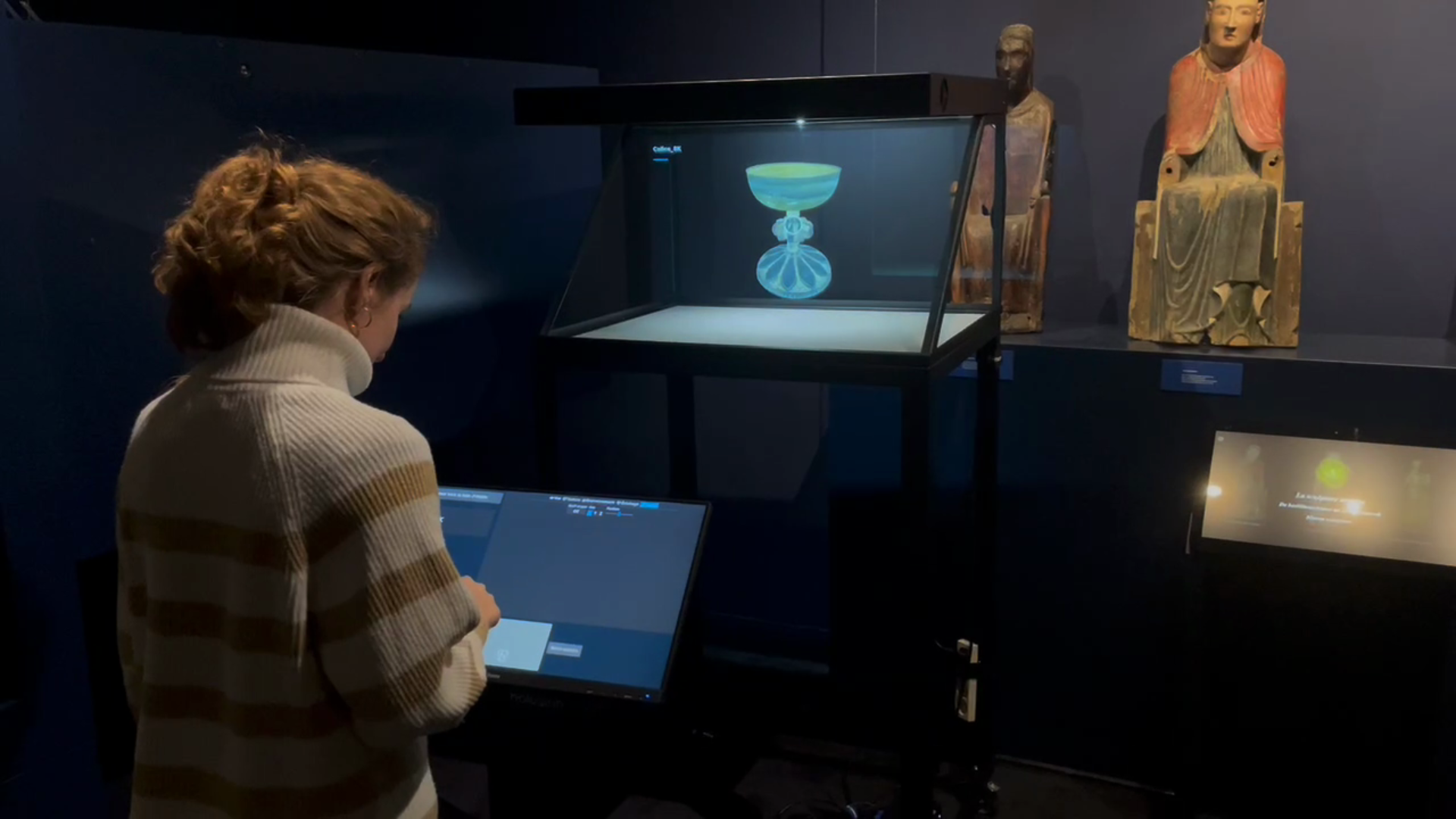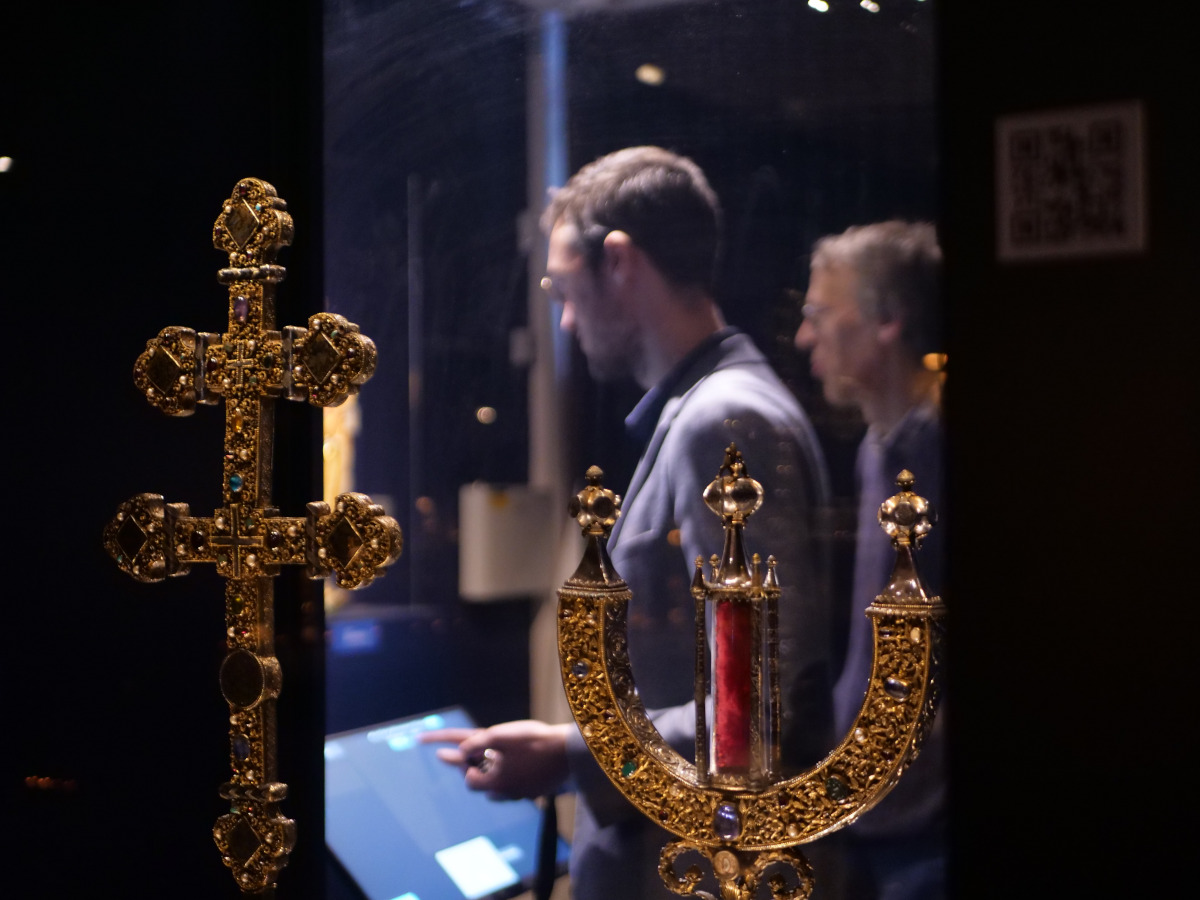Taking advantage of the 3D digitization of the treasure, the TreM.a Museum acquired from Holusion an Iris 32 holographic projector paired with a touchscreen and an eCorpus application to display in high resolution a selection of the most emblematic pieces from the collection.

The Treasures of Oignies, a Testament to Exceptional Medieval Goldsmithing Craftsmanship
It is at TreM.a, the Museum of Ancient Arts of the Namur region in Namur, Belgium, that more than fifty pieces of medieval goldsmithing from the Oignies treasure are exhibited.
Created in the 13th century by Brother Hugo of Oignies and his collaborators, these objects of exceptional quality testify to a unique mastery of Gothic goldsmithing, carefully combining the techniques of niello, filigree, and cast or worked plastic forms.
Composed mainly of reliquaries and textiles, this treasure was originally stored in the priory of Oignies, Belgium. Following the destruction of the site, the treasure was entrusted to the Sisters of Notre-Dame de Namur in 1818, before they donated it to the King Baudouin Foundation in 2010.
Comprising around fifty pieces and a true cultural heritage, the Oignies treasure is considered one of the seven wonders of Belgium.
Learn more about the exhibition of the Treasures of Oignies at TreM.a

A digitally preserved treasure
True masterpieces of international renown, these reliquaries had the honor of being the centerpiece of an exhibition at the Medieval Museum of Cluny in Paris: Marvelous Treasure of Oignies: Shards of the 13th Century. Following this renewed spotlight, the pieces in the collection were restored and digitized for the occasion by the Free University of Brussels.
A holographic system that showcases exceptional pieces for everyone
Subject to constraints such as oxidation, these metal objects tend to deteriorate if placed in poor conditions. They are protected in heavy display cases with climate control and under lighting that does not necessarily highlight the fine details of the engraved filigree or allow observation of the richly decorated backs.
Taking advantage of the 3D digitization of the treasure, the TreM.a Museum acquired from Holusion an Iris 32 holographic projector paired with a touchscreen and an eCorpus application to display in high resolution a selection of the most emblematic pieces from the collection.
This innovation allows for the semantic enrichment of the artworks through the annotation and article-writing system natively offered by eCorpus. The ability to freely zoom in on the filigree of the treasure’s pieces enables appreciation of unique details that are otherwise difficult for visitors to access. This tool can be especially useful during guided tours, where the curator can use the hologram as a presentation aid for the pieces, making it easier to highlight aspects of an object to a wider audience.
Mobile and easily transportable, this kiosk offers the possibility to bring the museum’s treasures beyond its walls, to schools, media libraries, and heritage discovery events.
To learn more about the exhibition Marvelous Treasure of Oignies: Shards of the 13th CenturyPrecious reliquaries, witnesses of a diligent monastic life
Taking advantage of the donations from the powerful churchman of Liège, Jacques de Vitry, then stationed in Rome, Hugo d’Oignies created very impressive objects, such as this corporal reliquary—so called because its shape directly refers to the part of the body from which the relic is believed to originate.
The saint’s rib is enclosed in a rock crystal tube that stands at the center of a silver semicircle adorned with stones. An “authentic” parchment certifies that the object was made by Brother Hugo in 1238. In a medieval context where the trade of relics was rampant, this type of certificate issued by ecclesiastical authorities attests to its value.
To view the eCorpus scene showcasing the reliquary of the saint’s rib
A complementary tool for a better understanding of the artwork
The innovation brought by the holographic kiosks adds an additional appeal to the Museum, offering an opportunity for the audience already familiar with the Treasures of Oignies to rediscover these unique works with fresh eyes.
Seeing the object floating in its display case offers a unique perspective on the artwork that a traditional touchscreen display cannot provide. Similarly, using it in combination with eCorpus makes visible details that a non-expert visitor might not otherwise notice.
eCorpus, an open-source software supported by Holusion, the University of Lille, and the University of Liège, is a tool for managing corpora of 3D digitized artworks. Collaborative and easy to use, it enables research, conservation, and mediation teams to carry out documentation, annotation, and animation work themselves.
This system both amazes its viewers and encourages them to return to the actual objects in the collection, allowing them to appreciate details they might not have noticed without the aid of the setup in the room.